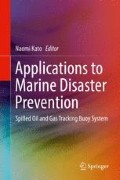Abstract
This chapter first describes past major marine-based oil spill and gas leak accidents around the world. The Deepwater Horizon (DWH) oil spill that occurred on April 20, 2010, in the Gulf of Mexico (GOM) is considered the largest in the history of the petroleum industry. Second, the investigations into the subsea environmental effects by the DWH oil spill accident are described from the viewpoints of tools, structure of subsurface plumes, and the effect of ocean circulation in the GOM on subsea hydrocarbon compound drifting. Third, surface oil slick behavior after the DWH oil spill accident is discussed from the viewpoints of satellite remote sensing and the effect of the GOM loop current. Finally, the impact of the DWH oil spill accident on contingency plan, preparedness, and regulations is explained.
Access this chapter
Tax calculation will be finalised at checkout
Purchases are for personal use only
References
Atwood DK (1980) Proceedings of a symposium on preliminary results from the September 1979 researcher/pierce Ixtoc-I cruise. Key Biscayne. 9–10 June 1980
Bennear LS (2015) Offshore oil and gas drilling: a review of regulatory regimes in the United States, United Kingdom, and Norway. Rev Environ Econ Policy 9(1):2–22. doi:10.1093/reep/reu013
Camilli R et al (2010) Tracking hydrocarbon plume transport and biodegradation at Deepwater Horizon. Science 330(6001):201–204. doi:10.1126/science.1195223
Clark RN et al (2010) A method for quantitative mapping of thick oil spills using imaging spectroscopy. U.S. Geological Survey open-file report number 2010–1167 (p 51)
Jones CE et al (2011) Studies of the Deepwater Horizon oil spill with the UAVSAR radar. In: Liu Y et al (eds) Monitoring and modeling the Deepwater Horizon oil spill: a record-breaking enterprise. AGU, Washington, pp 33–50
Joye SB et al (2011) Magnitude and oxidation potential of hydrocarbon gases released from the BP oil well blowout. Nat Geosci 4:160–164. doi:10.1038/ngeo1067
Kessler JD et al (2011) A Persistent oxygen anomaly reveals the fate of spilled methane in the Deep Gulf of Mexico. Science 331(6015):312–315. doi:10.1126/science.1199697
Kleindienst S et al (2015) Chemical dispersants can suppress the activity of natural oil-degrading microorganisms. PNAS 112(48):14900–14905, www.pnas.org/cgi/doi/10.1073/pnas.1507380112
Leifer I et al (2012) State of the art satellite and airborne marine oil spill remote sensing: application to the BP Deepwater Horizon oil spill. Remote Sens Environ 124:185–209. doi:10.1016/j.rse.2012.03.024
Liu Y et al (2011) Evolution of the loop current system during the Deepwater Horizon oil spill event as observed with drifters and satellites. In: Liu Y et al (eds) Monitoring and modeling the Deepwater Horizon oil spill: a record-breaking enterprise. AGU, Washington, pp 91–101
Mcginty S (2008) Fire in the night The Piper Alpha disaster. Pan Macmillan, London
Moller TH (1997) The NAKHODKA oil spill response – the technical adviser’s perspective. Petroleum Association of Japan (PAJ) oil spill Ssmposium 97, 10–11 July 1997, Tokyo: MODIS: http://modis.gsfc.nasa.gov/
National Commission on the BP Deepwater Horizon Oil Spill and Offshore Drilling (2011) Deep water – the gulf oil disaster and the future of offshore drilling – report to the president. Jan 2011, pp 1–398
Noth EW et al (2011) Simulating oil droplet dispersal from the Deepwater Horizon spill with a Lagrangian approach. In: Liu Y et al (eds) Monitoring and modeling the Deepwater Horizon oil spill: a record-breaking enterprise. AGU, Washington, pp 217–226
OGJ editors (2015) Statoil’s Gudrun condensate leak could have been major incident. Oil Gas J Online. 21 May 2015
Read C (2011) BP and the Macondo spill: the complete story. Palgrave Macmillan, New York
Reddy CM et al (2012) Composition and fate of gas and oil released to the water column during the Deepwater Horizon oil spill. Proc Natl Acad Sci U S A 109(50):20229–20234
Ryan JP et al (2011) A high-resolution survey of a deep hydrocarbon plume in the Gulf of Mexico during the 2010 Macondo blowout. In: Liu Y et al (eds) Monitoring and modeling the Deepwater Horizon oil spill: a record-breaking enterprise. AGU, Washington, pp 77–82
Ryerson TB et al (2012) Chemical data quantify Deepwater Horizon hydrocarbon flow rate and environmental distribution. Proc Natl Acad Sci U S A 109(50):20246–20253
Walker ND et al (2011) Impacts of loop current frontal cyclonic eddies and wind forcing on the 2010 Gulf of Mexico oil spill. In: Liu Y et al (eds) Monitoring and modeling the Deepwater Horizon oil spill: a record-breaking enterprise. AGU, Washington, pp 103–116
Weiberg RH et al (2011) Tracking subsurface oil in the aftermath of the Deepwater Horizon Well blowout. In: Liu Y et al (eds) Monitoring and modeling the Deepwater Horizon oil spill: a record-breaking enterprise. AGU, Washington, pp 205–216
White HK et al (2012) Impact of the Deepwater Horizon oil spill on a deepwater coral community in the Gulf of Mexico. Proc Natl Acad Sci U S A 109(50):20303–20308. doi:10.1073/pnas.1118029109
Wilson G et al (2013) Following the safe evacuation of all offshore personnel… the environmental response takes primacy: learning from the Elgin G4 Well major incident. SPE Offshore Europe Oil and Gas Conference and Exhibition, 3–6 Sept. Aberdeen. doi:http://dx.doi.org/10.2118/166590-MS
Author information
Authors and Affiliations
Corresponding author
Editor information
Editors and Affiliations
Rights and permissions
Copyright information
© 2017 Springer Japan
About this chapter
Cite this chapter
Kato, N. (2017). Lessons from Marine-Based Oil Spill and Gas Leak Accidents. In: Kato, N. (eds) Applications to Marine Disaster Prevention. Springer, Tokyo. https://doi.org/10.1007/978-4-431-55991-7_2
Download citation
DOI: https://doi.org/10.1007/978-4-431-55991-7_2
Published:
Publisher Name: Springer, Tokyo
Print ISBN: 978-4-431-55989-4
Online ISBN: 978-4-431-55991-7
eBook Packages: EngineeringEngineering (R0)

